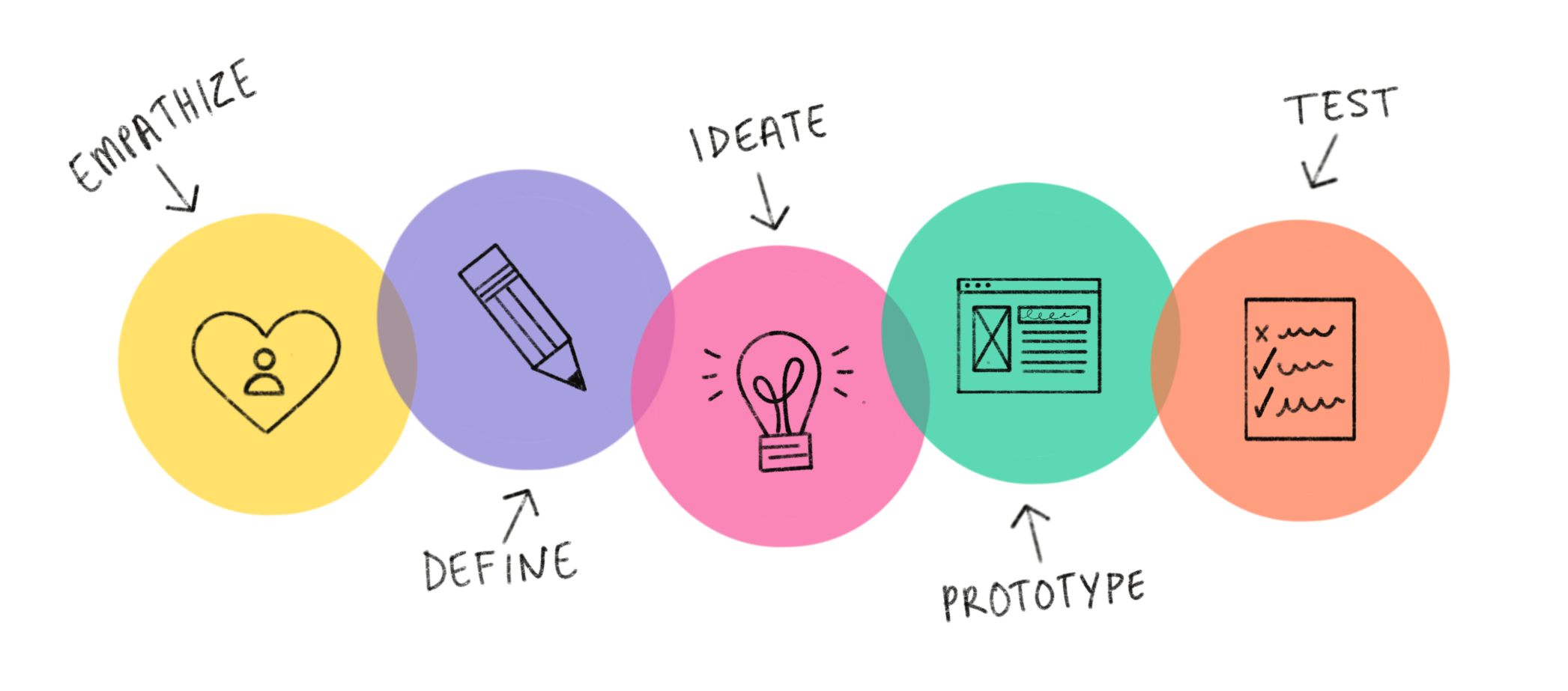Almost every innovative company worldwide uses some form of Design Thinking. Therefore, it becomes imperative to understand what Design Thinking is. It doesn’t matter whether you are a designer or product manager or work in a small company or a large corporation. Still, if your work involves innovation, design thinking will be an essential aspect of your career.
What is Design Thinking?

Design Thinking is a problem-solving approach centered on understanding the needs and perspectives of users to create innovative and effective solutions. It is a user-centric approach that emphasizes empathy, experimentation, and iteration.
What Are the 5 Steps of Design Thinking?
Design Thinking typically involves five steps: Empathize, Define, Ideate, Prototype, and Test. Even though the exercises or processes in each stage are very flexible and every designer or company does it differently, the five steps remain the same.
1. Empathize: Understand the users’ needs, requirements, and pain points by conducting user research and gathering feedback.
2. Define: Clearly define the target audience and the problem that needs to be solved.
3. Ideate: Generate a wide range of propositions for potential solutions to the problem at hand.
4. Prototype: Create a physical or digital representation of the best ideas to test and gather feedback.
5. Test: Gather feedback from users and test the effectiveness of the prototypes.
Design Thinking and Small Businesses
Small business owners are often so tremendously busy that they don’t have any time to take a step back and observe the patterns in their business. They fail to realize why the same problems keep occurring repeatedly. Design Thinking can help small businesses to monitor their patterns and evaluate what factors are disparaging growth. Design Thinking is how companies like Apple and Google analyze their problems and foster innovation.
How to Learn Design Thinking for Small Businesses?
Working professionals must take Design Thinking certificate courses to learn Design Thinking for small businesses. Design Thinking certificate courses are educational programs that teach individuals about the Design Thinking process and its applications. These courses can be taken in person or online.
Many online courses teach Design Thinking. Some are self-paced and can be completed at any time, while others are synchronous and are held in live sessions. Online courses can be an excellent option for individuals who want to learn at their own pace and schedule.
Obtaining a certificate in Design Thinking for small businesses can be beneficial for entrepreneurs and small business owners in several ways:
-
Official Recognition of Your Knowledge and Skills
A certificate in Design Thinking for small businesses formally recognizes an individual’s knowledge and understanding of the Design Thinking process and its applications. This can help entrepreneurs to demonstrate their expertise to potential clients, partners, or investors.
-
Professional Development
By completing a certificate program, entrepreneurs can deepen their understanding of Design Thinking and develop their skills in problem-solving and innovation. It can help them to create more effective and innovative solutions for their business.
-
Networking Opportunities
Many certificate programs offer networking opportunities with other professionals in the field. These opportunities can help entrepreneurs build a professional network and access valuable resources and expertise.
-
Competitive Advantage
By using Design Thinking, entrepreneurs can create solutions that genuinely meet the needs of their customers, leading to increased customer satisfaction and, ultimately, business growth, which can give entrepreneurs a competitive edge in their market.
-
Stay Ahead of the Curve
Obtaining a certificate in Design Thinking for small businesses can help entrepreneurs to stay ahead of the curve and be aware of the latest trends, tools, and methodologies in the field of Design Thinking.
To sum up, obtaining a certificate in Design Thinking for small businesses can benefit entrepreneurs and small business owners in several ways, such as official recognition of knowledge and skills, professional development, networking opportunities, competitive advantage, and staying ahead of the curve. It can also be a valuable addition to the CV of entrepreneurs seeking to demonstrate their ability to think creatively and solve problems in a user-centric way. It can be a good investment for the future of the business.
How Can Entrepreneurs Use Design Thinking to Grow their Businesses?

Entrepreneurs can use Design Thinking to grow their small businesses by understanding their customers, generating new ideas, and testing and iterating on solutions:
1. The first step in using Design Thinking to grow a small business is empathizing with customers. This means understanding their needs, wants, and pain points. Entrepreneurs can conduct user research and gather feedback through surveys, interviews, and focus groups. By understanding the needs of their customers, entrepreneurs can identify opportunities for growth and innovation.
2. Once the problem has been identified, the next step is clearly defining it. This means identifying the target audience, the problem they are facing, and the goal of the solution. By clearly defining the problem, entrepreneurs can ensure that they are working on the right solution and targeting the right audience.
3. The next step is to generate a wide range of ideas for potential solutions, known as ideation. Entrepreneurs can use various techniques such as brainstorming, mind mapping, and idea-generation sessions to develop new and innovative solutions. It’s crucial to encourage wild and diverse ideas at this stage.
4. After the ideation stage, entrepreneurs can create physical or digital prototypes of their best ideas to test and gather feedback, known as prototyping. The goal of prototyping is to create a tangible representation of the solution that can be tested and refined. It can be as simple as a sketch or as complex as a working model.
5. The final step is testing and gathering feedback. This is where entrepreneurs gather user input and test their prototypes’ effectiveness. Based on the feedback, entrepreneurs can adjust the solution and continue testing until they have a solution that meets the customer’s needs.
Design Thinking is a powerful tool for small businesses. It allows entrepreneurs to create solutions that genuinely meet the needs of their customers, leading to increased customer satisfaction and, ultimately, business growth.
Stanford Design Thinking
The Stanford d.school (Institute of Design at Stanford) is a leading institution in the field of design thinking and has been instrumental in popularizing the approach in education, business, and other industries. The Stanford design thinking approach is centered on “human-centered design,” which emphasizes user empathy, rapid prototyping, and iteration. Stanford Design Thinking programs are designed to be hands-on and project-based, with a focus on learning by doing. Students and participants in Stanford Design Thinking programs work on real-world challenges, using Design Thinking methods and tools to generate and test ideas.
Stanford Design Thinking has been widely adopted in education, business, and other industries. It has been used to solve many problems, from designing new products and services to improving healthcare and education. There are many successful stories of applying Stanford Design Thinking to real-world problems, such as the IDEO team that helped to design and launch the first Apple mouse and the team that redesigned the emergency room experience at Stanford Hospital.













































